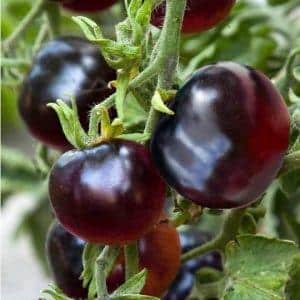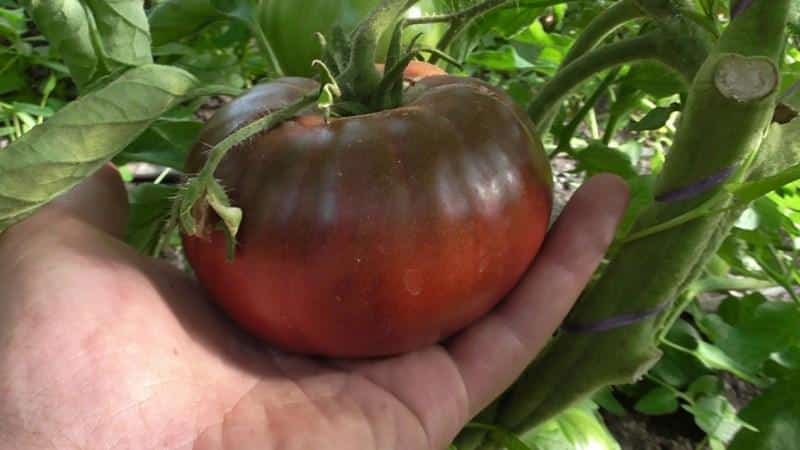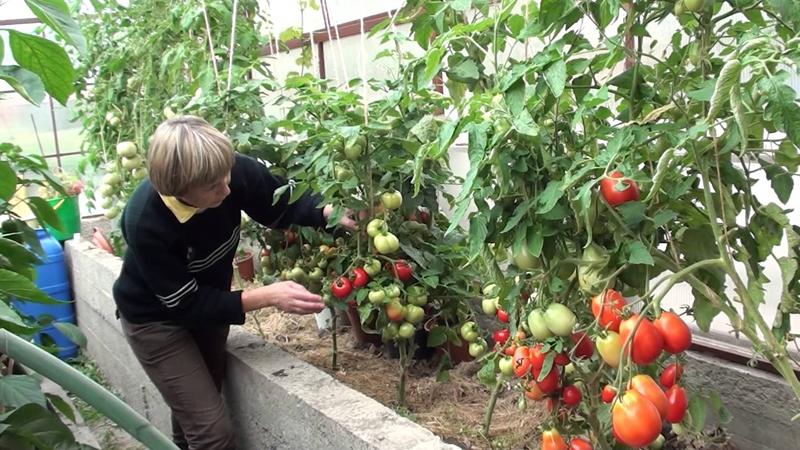An unusual and aesthetic variety of tomato “Black Baron” - easy to grow and pleasing with an abundance of harvest
Do you want to try large and beautiful tomatoes with an unusual black color? Among the “black” tomatoes, the Black Baron variety stands out especially. Let's look at its strengths and weaknesses, and also find out the features of growing dark-fruited tomatoes in a personal plot.
Description of the variety
Black Baron tomato stems are not limited in growth because variety indeterminate. Their height reaches up to 1.5-2 meters. The bush is spreading and produces a large number of green leaves.
The variety is mid-season in terms of fruit ripening. The first fruits ripen 110-115 days after seed germination. The first flower stalks form after 7-8 leaves open.
Baron's varietal feature is the rather large size of the fruit. Tomatoes grow up to 250-300 grams. The shape of the fruit is flat-round, with ribs extending from the stalk to the middle of the barrel.
The ripe fruits are dark burgundy with a chocolate-brown tint.
Fruit characteristics
Tomatoes of the Black Baron variety stand out for their high tasting scores. The pulp of the fruit is juicy, sweet and fleshy. There are up to six seed nests on a cut.
The tomato is intended for fresh consumption. Tomatoes look great in salads, burgers and other cold appetizers. Tomato juice from them is thick and, due to the color of the fruit, has an unusual color.
Since the fruits are large, they ripen in small clusters of 3 to 5 tomatoes.From one square meter of plantings, up to 6-7 kilograms of crops are harvested.
Differences from other subspecies
The Black Baron tomato is one of the most delicious among dark-fruited varieties. High taste characteristics are obtained due to the increased sugar content in the fruit pulp. In addition to taste, the tomato stands out for its unusual color and large fruits.
Origin of the variety and region of planting
There is an opinion that all black tomatoes arose thanks to genetic engineering, but this is a myth - all black varieties are easily amenable to natural selection.
The Black Baron tomato was bred by Dutch breeders. The variety is suitable for cultivation both in open ground and in greenhouse shelters. In southern regions with a mild climate, the variety is planted outdoors; in the middle zone and colder areas, when planted in a greenhouse, the plant feels better and produces a more stable harvest.
Advantages and disadvantages of the variety
Advantages of the variety:
- tasty, large and fleshy multi-locular fruits;
- high productivity;
- good resistance of the variety to nightshade diseases;
- The variety is not a hybrid, which allows you to independently prepare seed for next year.
Advice. To prepare the seeds yourself, select the ripest and largest tomato and place it in a bright place (for example, on a windowsill). Once the fruit is overripe and soft, remove, wash and dry the seeds.
Disadvantages of the variety:
- difficult to form a bush;
- In addition to the tall stem, due to the large fruits, the clusters also require garters, as they can break off;
- For good yield, the plant necessarily needs fertilizing.
How to grow black tomatoes on your plot?
The agricultural technology of black tomato varieties is no different from growing red analogues. Like other tomatoes, the plant is provided with regular watering, weeding and fertilizer.
Features of growing and caring for the variety
The Black Baron variety has an indeterminate stem that is not limited in growth. The height of the plant reaches 150 centimeters or more. In this regard, the trunk must be secured to a support. To avoid breaking off, clusters with large fruits should also be tied up.

Preparation of seedlings
Seeds are planted for seedlings 50-60 days before the intended planting in a permanent place of growth. Seeds are sown for germination in a common box to a depth of no more than 1-1.5 centimeters. For faster germination, seed treatment with growth stimulants is useful.
After opening 1-2 true leaves, the sprouts are pricked, that is, transplanted into an individual container in which they grow until planted in the ground.
The optimal temperature for growing seedlings during the day is 20-25 degrees, at night - not lower than +18 degrees.
Water the seedlings after the top layer of soil has partially dried and do not allow moisture to stagnate at the roots. It is better to water in the morning, since waterlogged soil at night will cause hypothermia of the roots. Plants will get sick or even die.
Reference. For good seedling growth, phosphorus-potassium fertilizers are used.
Landing rules
At the age of 60-65 days, after stabilization of positive night temperatures, the seedlings are transplanted to a permanent place. No more than 3-4 plants are placed on one square meter. The distance between plants is at least 50 cm, row spacing is at least 60 cm.
Add humus to the planting hole and pour it well with not very cold water.After planting, the seedlings are not watered for a week. The moisture added during planting will be sufficient.
On a note. The deeper the seedlings are planted, the more additional roots are formed on its stem.
Rules of care
The main task of the gardener in caring for the Black Baron is to correctly form the bush. The variety is tall and must be grown on a support or tied to a trellis or greenhouse.
The bush is formed into one or two stems. To do this, leave the lower stepson on the main plant. Subsequently, this place must be covered with earth, then the stepson will form its own independent root system. All other stepchildren must be removed!
Important! For healthy roots, the plant needs access to oxygen. To do this, the soil around the plant is kept loose and a hard crust is not allowed to form.
Do not forget to regularly remove weeds, because they take nutrients from the cultivated plant. In addition, weeding promotes loosening and additional aeration of the soil.
All large tomatoes require additional fertilizers, since the plant requires a lot of effort to grow large fruits. During the period of increasing green mass and growth of a young plant, tomato requires fertilizers with a high nitrogen content.
After the plant enters the flowering and fruiting period, the amount of nitrogen is reduced, giving preference to the potassium-phosphorus composition.
Watering
In order for the fruits to grow large, regular watering is important, but you should not allow the soil to become waterlogged. One or two deep waterings per week is sufficient.
Water It is better to plant adult plants, as well as seedlings, early in the morning, so that the earthen ball has time to dry out a little during the day.
If tomatoes grow in a greenhouse, it must be ventilated, because, unlike cucumbers, tomatoes do not like too humid air. Constant moisture on the leaves will provoke the growth of fungi and putrefactive bacteria.
Diseases and pests
There are a large number of varieties of nightshades diseases. Among the most dangerous are blossom end rot, Alternaria blight and the most common - late blight.
Important! Overmoistening of the soil is the most common cause of disease.
The Black Baron variety is quite resistant to diseases and has good immunity, but preventive measures will not hurt at all. Let's consider the main causes and methods of preventing diseases.
Apical rot
The first sign of the disease is the appearance of watery spots on the tomatoes, which quickly grow and acquire a brown tint. The main causes of blossom end rot are temperature changes and lack of calcium in the soil. Excess nitrogen and high humidity also increase the likelihood of disease development.
For treatment, the leaves of the diseased plant are treated with a solution of calcium chloride.
Adding calcium as part of complex mineral fertilizers will be a good preventative measure.
Alternaria blight
Signs of the development of Alternaria include the appearance of small (up to 1 cm in diameter) dry gray spots. They appear first on the lower leaves. The disease then progresses and spreads to the entire plant.
A diseased bush will have to be treated with fungicides (for example, Kuproksat, Infinito).
Prevention of the disease consists of disinfecting the seeds and soil before planting, for example, with a strong solution of potassium permanganate.
Late blight
 The causative agent of late blight is a fungus that first settles on the leaves in the form of grayish-brown spots and then consumes the entire plant. When humidity is high, fluffy plaque grows. After spots appear on the fruit, the tomato rots.
The causative agent of late blight is a fungus that first settles on the leaves in the form of grayish-brown spots and then consumes the entire plant. When humidity is high, fluffy plaque grows. After spots appear on the fruit, the tomato rots.
The main factors in the development of the disease: temperature changes, high humidity and rainy weather. On sunny days the disease is rare.
Late blight will be slowed down in the early stages only by fungicides (chemical: “Bordeaux liquid”, “Ridomil”; biological: “Fitosporin”, “Ecosil”) and the removal of affected leaves, and in the advanced stage - the entire plant.
As a preventive measure:
- regularly spray the bushes with fungicides (for example, biological) as soon as the temperature drops below +15 degrees;
- remove and burn diseased leaves;
- pick green fruits for ripening.
For disinfection, the removed fruits are kept for 1-2 minutes in water at a temperature of 60 degrees.
Growing tricks: advice from experienced summer residents
Let's list a number of useful tips and tricks, shared by experienced gardeners. With their help, it is easier to achieve a stable tomato harvest at your summer cottage.
Tips and Tricks:
- When removing stepsons, leave a small stump of 2-3 cm, then a new stepson will not grow from the sinus.
- To keep the humidity in the greenhouse lower, water the plant through a bottle buried next to the bush. This way the soil will be dry and crumbly, and moisture will flow directly to the roots.
- To prevent late blight in the greenhouse, place 2-4 open bottles of iodine. Its vapors effectively fight fungus.
- Before planting seedlings, disinfect the bed with a strong solution of potassium permanganate.
- If dark spots appear on the leaves and fruits, apply potassium fertilizers to increase the plant's immunity and solve the problem.
- If aphids appear on the leaves, wash them off with warm water and green soap.
- Slugs are afraid of ammonia. To solve this problem, spray the leaves and soil around the stem with an aqueous solution of alcohol.
- Flying insects do not like strong odors. They will be scared away by a tincture of chamomile, garlic or celandine.
Reviews
In their reviews, gardeners who tried to grow the Black Harrow variety noted both its positive and negative features.
Among the positive points:
- the fruit fully corresponds to the characteristics and photos declared by the manufacturer;
- high seed germination;
- delicious fleshy fruits;
- reviews of the Black Baron tomato confirm the stated yield of over 5 kg per bush.

Among the negative features:
- Ripe tomatoes need quick processing because they are not stored for a long time.
- Some gardeners have had problems with the ovaries falling off. However, it is difficult to know what the real reason was, since it also occurs due to a lack of nutrients, watering with cold water or high humidity.
Conclusion
Among the “dark-skinned” tomatoes, the Black Baron variety stands out for its high taste characteristics. High yield, large fruits and stable immunity increase the attractiveness of the variety. It’s definitely worth trying to grow it yourself in order to surprise your loved ones with beautiful, unusual, and most importantly - delicious tomatoes on your desk.